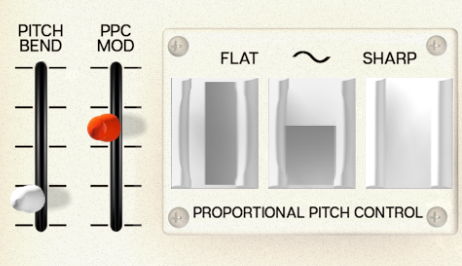Proportional Pitch Control (PPC) was a new form of left-hand expression control that was introduced on a number of ARP synthesizers in the mid-1970s, including the Odyssey. It was created to answer musicians' requests for a more fluid and expressive way to bend pitch than the awkward knob that had been common on the Mk I and most Mk II Odysseys.
PPC, which was a stock feature on the Mk III and an optional retrofit for earlier models, consisted of three rubberized pressure pads. The player rested three fingertips on them while playing the keys with the other hand. Pressing down on the left pad with the ring finger caused a down (flat) bend, pressing the right pad with the index finger caused an up (sharp) bend, and pressing the center pad with the middle finger added modulation (vibrato, indicated with a sine wave graphic).
This was a very unusual way to control a synth. While some players never took to it, others loved it, and it became a valued feature and frequently-installed retrofit to older Odysseys. In fact, PPC was so popular that when the Odyssey's smaller sibling the Axxe added it, users of the older Axxe demanded a retrofit even though there was no room for three pads on older Axxes' front panels. The solution? A single PPC pad with a 3-way switch to control what it was doing!
Naturally, you can't press your fingers against your computer monitor to make ODC 2800's PPC controls work, but they do change shading to indicate that the instrument is receiving pitch bend or modulation (MIDI CC 1) data. This comes in the form of dark gray "level meters": right to left for down bend, bottom to top for modulation, and left to right for up bend. The screenshot above shows a moderate amount of modulation and a nearly-100% down bend.
The associated control sliders are:
Pitch Bend: Sets the full range of the pitch bend control, from 0 to ±12 semitones. The default is ±2 semitones, a full step up or down.
PPC Mod: Controls how strong the modulation signal is for a given amount of pressure on the Modulation pad. Higher values turn relatively small Modulation movements into very heavy vibrato.
As of this writing, there are no generic MIDI controllers with PPC pads on them, which is a pity: it's a very nuanced way to add bends and vibrato to soloing. Of course, ODC 2800 will follow MIDI Pitch Bend and Mod Wheel (CC 1) messages from any controller you have connected, and the two sliders let you set the response to your taste for each patch.
